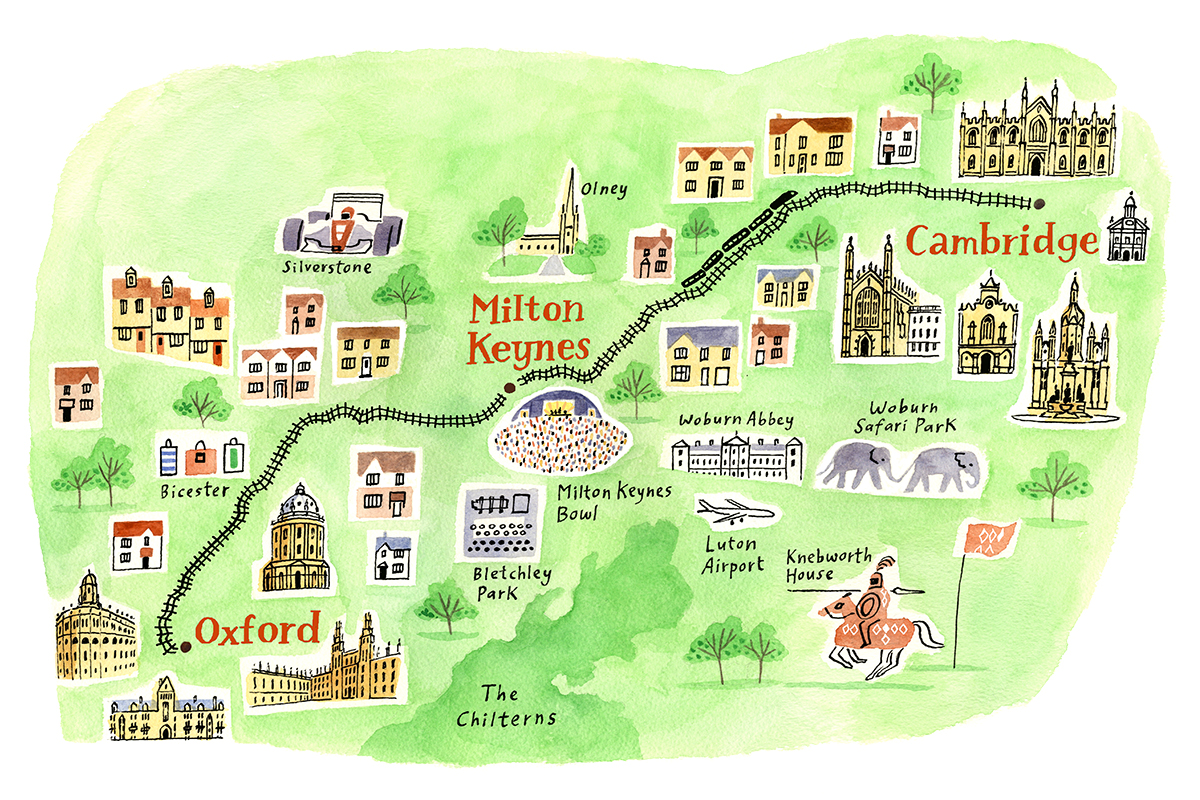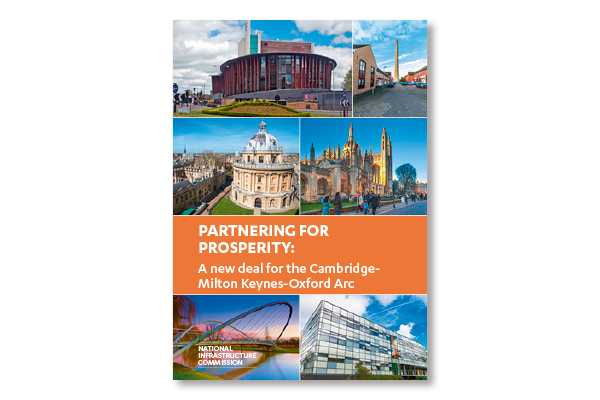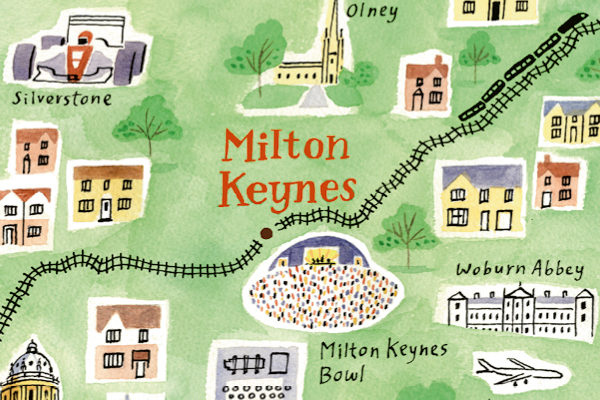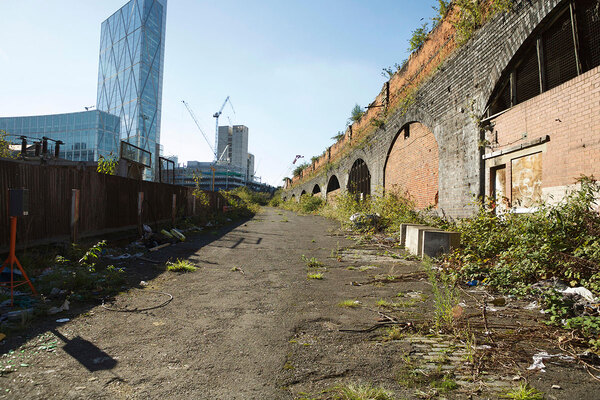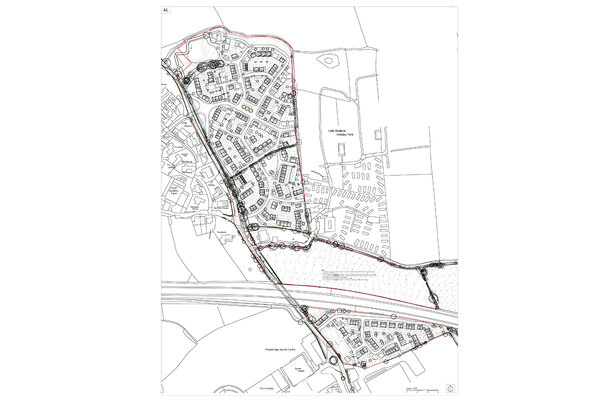You are viewing 1 of your 1 free articles
Arc of promise: plans for a million homes on Britain’s ‘brain belt’
A new trainline and a million homes are to be built in a 130-mile arc north of London. Gavriel Hollander reports. Illustration by Sarah McMenemy
When future historians assess David Cameron’s premiership, it’s safe to assume they will focus on the loss of the biggest political gamble in living memory.
But tarnished as the former prime minister’s legacy has been by Brexit, there’s one small part of it that might give him some satisfaction. Back in his early days at Number 10, Mr Cameron and George Osborne’s big idea was something they called ‘localism’.
This was essentially the devolving of power from Westminster into the regions, creating larger combined authorities and handing autonomy to newly created regional mayors.
Although the localism agenda may have slipped from the national consciousness in recent years, its fruits are starting to be borne.
"A third regional force is emerging – one which could transform housing, locally and nationally."
The Northern Powerhouse and the Midlands Engine are already firmly established concepts. Now, a third regional force is emerging – one which could transform housing, locally and nationally.
The less snappily named Cambridge-Milton Keynes-Oxford Arc is the subject of a major report from the independent National Infrastructure Commission (NIC) and subsequently formed one of the centrepieces of chancellor Philip Hammond’s November Budget. The proposals laid out by the NIC are ambitious.
It recommends the construction by 2050 of a million new homes in the 130-mile ‘arc’ 50 to 60 miles north of London (see map overleaf), effectively doubling current housebuilding rates in the area. Although there are no firm targets for how many of these are to be affordable, the aim is to drive down the cost of housing and encourage economic growth.
Crucially, this surge in housebuilding would be supported by and supportive of a £7bn investment in transport infrastructure along the so-called ‘brain belt’ connecting the homes of the world’s most famous universities.
This would include an east-west rail line and an Oxford-Cambridge express road link.
The economic case for investing in this area is hard to argue with. According to the NIC, the arc’s gross value added (GVA) in 2014 was £90.5bn. The report predicts that just building the two new pieces of transport infrastructure would almost triple the GVA to £250bn as a result of new business coming to the area.
“In order to sustain the region’s economic output, we need new and affordable homes.”
Whitehall watchers know these numbers are all well and good, but there will be no economic uplift until spades hit the earth. In this case, that means building the homes to support the new transport links. “There is an absolute desperate need for housing,” agrees Sadie Morgan, one of the NIC commissioners. “In order to sustain the region’s economic output, we need new and affordable homes.”
But doubling housebuilding delivery and maintaining it for 30 years is easier said than done. Where will these new homes go? How will they be delivered? And what are the challenges ahead for those involved in making the NIC’s dream a reality?
On the first question, the report offers a piecemeal solution. Some of the million extra homes are already accounted for by local plans, while others will involve the expansion of existing large conurbations. But the most eye-catching proposal is for building entirely new communities and using new town development corporations for the first time since the 1990s. This implies a recognition that planning on this scale must look beyond council borders.
“This is the first strategic plan we’ve had for 20 years that is genuinely looking at different infrastructure needs and how they relate to housing. It enables local authorities to look at needs not just within their boundaries,” says Katy Lock, project and policy manager at the Town and Country Planning Association, which has long called for a new wave of garden city development in the UK.
“This is the first strategic plan we’ve had for 20 years that is genuinely looking at different infrastructure needs and how they relate to housing", Katy Lock, TCPA
The use of some form of development corporations with the power to pull together large chunks of land is widely seen as the only way to build homes on the scale outlined by the NIC. James Scott, director of planning at strategic developer Urban & Civic, points out: “You won’t deliver for that demand on incremental development; you need big-scale solutions. If you’re looking at settlements of up to garden town level of 10,000 units, you can deliver those through privately assembled land blocks. When you go beyond that and look at garden city kind of level, you have to think about how to get those going.”
The problem with building entirely new settlements is where to put them. Although Mr Scott says there are conversations in local authorities “that haven’t been happening in 10 or 15 years” about garden towns and cities, others acknowledge that new development brings with it local disquiet.
That opposition could already be fermenting. In an auxiliary report by planners 5th Studio, published by the NIC, the villages of Biggleswade and Calvert are mooted as possible sites for new towns, with local press and politicians already picking up on the proposals. The NIC insists these are merely “illustrative” suggestions, but a source familiar with plans around the arc calls the naming of sites “naïve”.
As James Palmer, mayor of Cambridgeshire and Peterborough, adds: “People who have houses are anti other people having them. In every town and village where housing estates are being built there is very vocal opposition from a few people who have undue influence on the planning process.”
This is why planning is often cited as a potential hurdle if the arc’s housebuilding ambitions are to be achieved. But here, again, the localism agenda could be tilting the balance back in favour of development.
The concept of urban mayors and city deals is another surviving piece of the Osborne/Cameron localism project. Having already secured city deals, both Cambridgeshire and Peterborough together and Oxfordshire are working on joint spatial plans that go beyond traditional local authority borders. And these plans aim for big numbers when it comes to housing. Mr Palmer says Cambridgeshire is 100,000 houses short of what is needed to meet even current demand, while in Oxfordshire, plans are already in place for a similar number of new homes by 2031.
To reach these goals, though, government needs to give local authorities the tools to build, according to Caroline Green, assistant chief executive of Oxford City Council and former housing lead at the Local Government Association.
“This is the first strategic plan for 20 years that is genuinely looking at different infrastructure needs.”
“An important part of making a success of the corridor is recognising the need for a more interventionist approach [from councils], whether that’s development corporations for new towns or local authorities being able to have greater levers to make sure what’s allocated in their plans gets delivered.”
If that begins to explain how a million homes will be built, there is still the question of who will build them. Urban & Civic could be a major player; it has 5,000 acres of strategic land, 20,000 consented homes and another 10,000 in progress. But housing associations and councils will have to play a big part to get anywhere near the number of homes required to make the arc the economic powerhouse the government envisages.
“If you want to double your housing output it’s unlikely the market will deliver that,” suggests Kevin Bolt, chief executive of BPHA, one of the region’s leading social landlords, with 18,000 homes. “The involvement [of associations] needs to increase. If you read the [NIC] report there is very little mention of associations. They need to raise their profile considerably.”
There is little detail on tenure mix in the report, although Ms Morgan insists that “proper affordable, liveable homes… have to be part of the mix”, adding that she would “expect housing associations to play a big role” in delivery.
Mr Bolt says it is an opportunity for housing associations to “show what they can bring to the table”. He adds: “They are going to have to up their game or I can’t see the affordable housing element being met.”
That said, for Mr Palmer, affordability means reducing prices as much as increasing the supply of sub-market rental properties. A shortage of consented land means in parts of Oxford, house prices are 16 times average earnings, while in Cambridge they run as high as 18 times earnings. “In Cambridgeshire, people not getting on the housing market is our biggest issue,” he says. “We have high employment so getting people on the market is as important as social housing.”
He insists that the backing of government and the development of better transport links can see all tenures flourish: “When you are playing at scale and the government is doing the heavy lifting on the infrastructure commitments, then the affordable housing will naturally increase.”
If he is right, and the optimism about the arc is justified, then it might just turn out that Mr Cameron’s largely forgotten localism initiative could be the catalyst for a minor housebuilding revolution.
